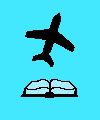 Return to
Return toAviation Answer-Man
Gateway
 Return to
Return to
Aviation Answer-Man
Gateway
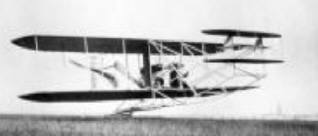 Return to
Return to
Yankees & Cats
A Quick History of
Copyright 2000, 2001, 2003 by R.Harris
Before Grumman Aircraft (famous for naval aircraft) gave up its Gulfstream Jet super-bizjet line (as noted above), it tried to expand into general aviation, by buying the American Aviation line of very-light single-engine aircraft. Though short-lived, the Grumman/American line of light planes were a shock to the old-line light-plane makers (particularly Cessna and Piper) who had done little to update their line in over a decade. The Grumman/Americans brought real excitement to a market dominated by sluggish machines -- and showed that performance and price don't always go hand-in-hand, that there was more progress to be made in general aviation, and that a little ingenuity and initiative can still make a big difference. ---------------------------------
The "American Aircraft" line started with Jim Bede -- a designer of high-performance light planes, especially homebuillt aircraft designs and kits. Bede's first popular design, the BD-1, was a small, fast, low-wing, 2-place (side-by-side) plane. A rare photo of the BD-1 in flight, seen here, below, shows its clean, simple lines, and compact size.
However, there were shortcomings to the wing. The short, symmetrical-airfoil wing didn't offer a lot of lift, except at considerable speeds of 80 miles per hour or more. And a stall -- the sudden loss of lift when airplane speeds get too low, or when flight angle changes abruptly -- happened more readily (and with less warning) on the Bede's wing, than on most other planes it its class. Flaps on the trailing edge of the wing were valuable for helping other planes fly well at slower speeds, by exaggerating the curvature of the wing when lowered. But the BD-1's flaps -- though extending along 70% of the wing's trailing edge -- were rather short and ineffective. Coupled with the short, symetrical-airfoil wing, that meant fast take-offs and landings -- more dangerous than other planes the same size (which could fly slower on take-off and landing).
And any turbulence posed a greater risk of upsetting the short-coupled little airplane, than it did to competing airplanes whose wingspans were greater and whose tails were longer.
Another flying surface that offered parts interchangeability was the tail assembly: the vertical tail, and two horizontal tails (left and right) were all identical, permitting one-third the number of different parts in the tail assembly -- again saving money in design, manufacturing, and spare parts. The wing's main spar was an ingenius model of efficiency, too. To hold the wing together, and connect it to the plane, most airplane wings had a few thick rail-like spars stretching the width of the wing (particularly a stout "main spar"), with aluminum-shell fuel tanks in between the spars. But the BD-1's only large wing spar was a huge, stout aluminum tube (one on each side), about as big in diameter as the maxium thickness of the wing -- which doubled as the small plane's fuel tank.
Focusing on the budget flyer, Bede designed the BD-1 so that the wings could be removed after flight, so that the plane could mounted on a small trailer and be towed home behind a car, to be stowed in a garage -- saving the frugal owner the costly monthly rental of an airport hangar or tiedown space.
The BD-1 was initially offered with a variety of engines, from the dinky 65-horsepower Continental A65 (which powered the ancient J-3 Piper Cub) to the modern 108-horsepower Lycoming 0-235. Even a used, rebuilt 90-horsepower Continental was offered. Performance varied accordingly. But on almost any engine, the BD-1 was a faster plane than just about anything else using the same engine.
The single-piece, fiberglass main landing gear struts were simple and practical, and endured the impact of hard landings well. If damaged, replacement of the simple landing gear was fairly inexpensive.
The nose gear, too, was a model of simplicity. Other "beginners" planes commonly had steerable nosewheels (controlled by the rudder pedals), with "oleo-strut" shock absorbers built in. Though providing good ground manuverability and soft landings, they were expensive to manufacture, and often suffered from botched landings, requiring frequent (expensive) maintenance.
Bede used, instead, a simple "free castering" (loose, unsteerable, free-swiveling) nosewheel, requiring the pilot to steer by rudder at high speeds, and at low speeds by "differential braking" (using the left and right main-wheel brakes separately, using "toe brakes" -- by pressing on at the tops of the left and right rudder pedals). As for shock-absorbing, the nosewheel strut is simply a long tube of spring steel -- simple, but functional. However, although the BD-1 nosegear and main gear could absorb hard landings, they did not prevent the bouncing that shock-absorber struts did.

Grumman/American Aircraft

All Rights Reserved

From
Grumman-Gang (www.grumman.net)
:
brochure, Bede BD-1, Yankee's progenitor.
 The BD-1 was designed for quick-and-easy mass production, replacing the time-consuming business of airplane-riveting with the more sophisticated use of metal-to-metal bonding. The BD-1 also eliminated the complex skeletons of a modern lightplane by using half-inch-thick walls of aluminum "honeycomb sandwich" material - a sandwich made of two thin sheets of aluminum skin (one on the outside and one on the inside) connected by a lightwieight aluminum honeycomb "filling" for rigidity. Though involving some extremely expensive bonding material (metal "glue"), the process eliminated much heavy aluminum framework, and the costly, tedious process of riveting skin and skeleton to hold it all together. And with very few rivet heads protruding from its skin, the smooth-skinned BD-1 enjoyed less drag than similar-sized planes, permitting faster and more efficient flight.
The BD-1 was designed for quick-and-easy mass production, replacing the time-consuming business of airplane-riveting with the more sophisticated use of metal-to-metal bonding. The BD-1 also eliminated the complex skeletons of a modern lightplane by using half-inch-thick walls of aluminum "honeycomb sandwich" material - a sandwich made of two thin sheets of aluminum skin (one on the outside and one on the inside) connected by a lightwieight aluminum honeycomb "filling" for rigidity. Though involving some extremely expensive bonding material (metal "glue"), the process eliminated much heavy aluminum framework, and the costly, tedious process of riveting skin and skeleton to hold it all together. And with very few rivet heads protruding from its skin, the smooth-skinned BD-1 enjoyed less drag than similar-sized planes, permitting faster and more efficient flight. The BD-1 also reduced drag by having a shorter wing. And to make the airplane suitable for acrobatic flying, Bede designed it with a slender, "symmetrical" shape (the top and bottom both were curved the same). In theory, this was better for stunt flying, since the wing flew as well upside-down as it did right-side-up, and the shape was more streamlined. Another advantage of the symmetrical airfoil was the fact that parts of the left and right wings were basically interchangeable, doubling the "economy of scale" in manufacturing those parts of the plane and in stocking and selling replacement parts.
The BD-1 also reduced drag by having a shorter wing. And to make the airplane suitable for acrobatic flying, Bede designed it with a slender, "symmetrical" shape (the top and bottom both were curved the same). In theory, this was better for stunt flying, since the wing flew as well upside-down as it did right-side-up, and the shape was more streamlined. Another advantage of the symmetrical airfoil was the fact that parts of the left and right wings were basically interchangeable, doubling the "economy of scale" in manufacturing those parts of the plane and in stocking and selling replacement parts.
By adding a more traditional airfoil shape to the wing (curved a lot on top, and fairly flat on the bottom), Bede tamed the BD-1's wilder flying characteristics, to produce the first production model, the AA-1 Yankee, which was manufactured by Bede's new company,
American Aircraft. The plane was still a bit "hot" to handle, but safer and more practical -- especially for the inexperienced (low-time) pilots, whom Bede saw as his most likely customer. A compact, sleek, sporty little metal airplane, with side-by-side seating for two, it was distinguished by a sliding bubble canopy covering the "climb-down-in" cockpit. Bede also enlarged the rear side windows (the earliest BD-1 didn't even have any), and tinted the canopy to shield occupants from the sun.
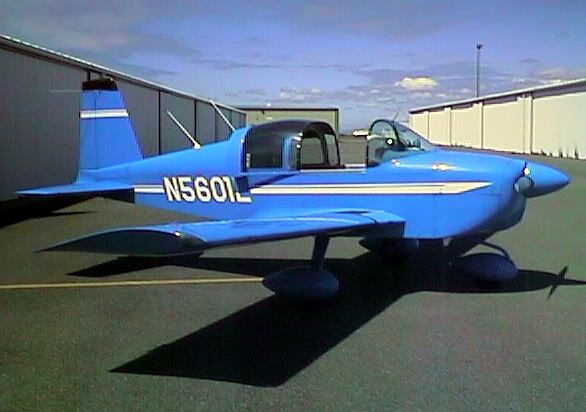
From
Grumman-Gang (www.grumman.net)
: Yankee Trader S/N 003, first AA1 sold.
Settling on the 108-horsepower Lycoming O-235 engine, the Yankee became a respectable airplane, with good crusing performance. Using the promotional hype for which he was to become famous (and infamous), Bede offered the plane for sale at only $2,500, and promised speeds up to 144 miles per hour. (See the deceptive American Aviation speed "graph" below, left). By comparison, the most popular 2-seat airplane of the day was the sedate Cessna 150, selling for about double that amount, and topping out at only 122 miles per hour -- using the same engine. Though the small Cessna had vastly superior low-speed (take-off and landing) performance, gentle manners, and a great view of the ground beneath its high wings, it was hard-pressed to match the sexy pizzaz and efficient hustle of the cheap, little Yankee. (Small wonder, then, that Cessna aircraft soon hired away American Aviation's president, Russ Meyer, to become the president of Cessna -- a post he would then hold for over a decade.)

|
|
From
Grumman-Gang (www.grumman.net)
:
Yankee performance promises. |
By the same token, it might be argued that the stout Cessna, Piper and Beech planes were better built for the crashes that plagued inexperienced pilots. Just as important, their longer wings offered better gliding performance -- an essential consideration when the engine quits. And in-flight engine failures are an especially common problem of inexperienced, budget-conscious flyers (like those whom Bede targeted for his planes): their frequent lack of pilot proficiency, amateur inspection habits, and stingy maintenance often increase the risk of engine failure.
 Bede's performance claims for the Yankee raised a few eyebrows -- some in genuine suspicion (see American Aviation's ridiculously distorted climb performance "graph" at left, showing the Yankee climbing out at about twice the angle of its leading competitor, despite only actually having about 25% more official climb performance.) Nevertheless, the Yankee promised flying excitement that was far beyond the budget of most pilots, except in a Yankee.
Bede's performance claims for the Yankee raised a few eyebrows -- some in genuine suspicion (see American Aviation's ridiculously distorted climb performance "graph" at left, showing the Yankee climbing out at about twice the angle of its leading competitor, despite only actually having about 25% more official climb performance.) Nevertheless, the Yankee promised flying excitement that was far beyond the budget of most pilots, except in a Yankee.

|
|
From
Grumman-Gang (www.grumman.net)
: Admiring eyes on the sporty Yankee. |
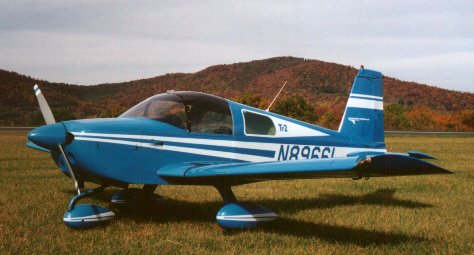

Four seats are better than two!
The American line came of age with the addition of a couple of enlarged, 4-place versions of the Yankee -- the Traveler and the Tiger, and their offspring:

|
| From Grumman-Gang (www.grumman.net) : AA-5 Traveler, original model. |
AA-5B Tiger
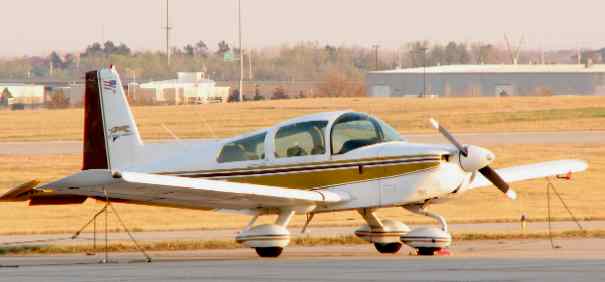
|
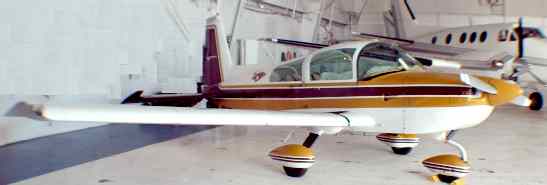
|
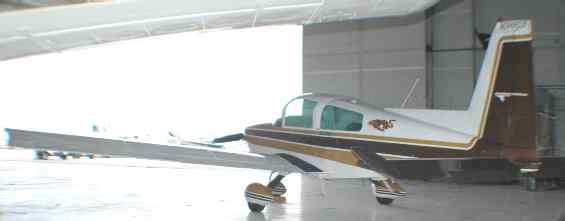
|
|
Grumman-American AA-5B Tiger (photos by RH & S.Alexander)
|
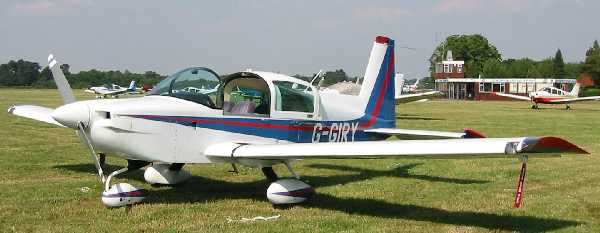
|
| From Grumman Gallery at grumman.net : AG-5B. |
This is an improved AA-5A, boosted with a bigger engine and with a larger horizontal tail. It mixed plenty of power with 4 full seats and full fuel, along with Yankee efficiency and speed, to quickly became a very hot item in the light plane market.
When Grumman got out of the light plane business, and discontinued the manufacturing of the Tiger, it became one of the most-sought-after light planes on the used market, where it now commands a premium price for airplanes in its class. It is commonly compared to the slower Piper Cherokee 180 / Archer, and to Beech's Musketeer Super / Sundowner (which uses the same engine, but flies much slower). But the fixed-gear Tiger also compares quite favorably to the speedy, retractable geared Mooney M-20's.

 When American Aviation foundered, in the mid-1970's, the line was picked up by Grumman Aircraft, and marketed as the "Grumman-American" line. Perhaps Grumman was thinking that the highly-regarded American "Tiger" would enhance the reputation of Grumman's other cats -- the AgCat cropduster, the F-14 TomCat fighter, and future fighter aircraft (which Grumman habitually named "-cat", such as the World War II Wildcat and Hellcat, and the F9F Panther and F11F Tiger jet).
When American Aviation foundered, in the mid-1970's, the line was picked up by Grumman Aircraft, and marketed as the "Grumman-American" line. Perhaps Grumman was thinking that the highly-regarded American "Tiger" would enhance the reputation of Grumman's other cats -- the AgCat cropduster, the F-14 TomCat fighter, and future fighter aircraft (which Grumman habitually named "-cat", such as the World War II Wildcat and Hellcat, and the F9F Panther and F11F Tiger jet).
This is the time of peak production, and the period in which the American lineup finally reached its potential.
One of the best things to come from this was an aerodynamic "touch-up" of the line, by aeronautical engineer Roy LoPresti. Lopresti improved the engine air intakes, and streamlined the landing gear, gaining an extra few miles per hour for all of the American line, resulting in the 2-seat AA-1C Lynx and T-Cat, and the 4-seat AA-5C Cheetah.
However, light plane manufacturing was not all that profitable in the 1980's, as the proliferation of professional lawyers and amateur pilots in the 1970's led to an explosive growth in post-crash lawsuits against lightplane manufacturers in the 1980's. Grumman, one of the leading U.S. makers of military aircraft, was preoccupied with the much-more-profitable, big-ticket sales of military aircraft -- and really didn't need the hassles (and potential bad publicity) afforded by little planes, flown by ill-trained civilian private pilots, and struggling in the depressed general-aviation market of the early 1980's.
When Grumman decided to dump the American line, in the 1980's, the Bede/American/Grumman "cats" disappeared altogether for a while -- except for the hundreds of used models which maintained a high level of popularity in the market.
In the 1990's -- largely because of the extreme popularity of the ideal-performing AA-5B Tiger -- the AA line was bought by a Southern U.S. venture, called AGAC (American General Aircraft Corp.) The AA-5C Tiger was revived as the AG-5B Tiger. The other models are waiting in the wings for revival.

|
| From Charlie's Airplane Page : the sleek AA-7 Cougar (later SOCATA TB-360 Tangara version, actually). |
COMMENTS:
The American line of planes are famed for their performance, affordability, simplicity, and efficiency.
Smaller and lighter than others in their class, and with very clean lines, the Americans are FAST, compared to other planes with the same horsepower and load, and have a well-deserved "sporty" reputation. Drag is reduced by the use of a small fuselage (but with plenty of room for occupants), short wing, and smooth skin (flush-mounted rivets, and metal-to-metal bonding, in place of rivets). Slick and light, they go fast on modest amounts of power. The fixed-gear AG-5B Tiger can outrun some retractable-geared Mooney planes, with the same load, on a similar engine and with similar fuel-consumption. The Tiger is 20 miles per hour faster than the Beech Musketeer using the same 180-hp engine.
The Americian line's aerodynamic efficiency, light weight and extreme simplicity, reportedly results in reduced operating costs. However, their smaller size tends to offer less protection in a crash.
On the negative side, the smaller models (AA-1 series) are notoriously "hot" airplanes for their class, requiring higher-than-normal landing-approach speeds, requiring greater care in slow-speed flight, and having greater susceptibility to turbulence, stalls and spins than other aircraft in their class. However, though the smaller AA-1 series planes are not forgiving aircraft, the larger AA-5 series and AA-7 series American models are better-behaved.
 A characteristic of the single-engine Americans is their "bubble" canopy, which slides back on rails. This is a plus and a minus. On the minus side, this means there are no doors: you must climb over the side of cockpit to get in and out. And during a rainshower, opening the canopy is a messy business. On the plus side, the canopy offers outstanding visibility for a low-wing plane, and it can be opened part-way during flight, for an even better view, not to mention the thrill (and ventilation) of open-cockpit flight. A down-side is the risk posed from "flip-over" crashes, since there is not much metal structure over the pilotís head. Also, the act of replacing a damaged forward side window, which is relatively cheap on almost any other plane, becomes the expensive process of replacing an entire canopy on an American.
A characteristic of the single-engine Americans is their "bubble" canopy, which slides back on rails. This is a plus and a minus. On the minus side, this means there are no doors: you must climb over the side of cockpit to get in and out. And during a rainshower, opening the canopy is a messy business. On the plus side, the canopy offers outstanding visibility for a low-wing plane, and it can be opened part-way during flight, for an even better view, not to mention the thrill (and ventilation) of open-cockpit flight. A down-side is the risk posed from "flip-over" crashes, since there is not much metal structure over the pilotís head. Also, the act of replacing a damaged forward side window, which is relatively cheap on almost any other plane, becomes the expensive process of replacing an entire canopy on an American.
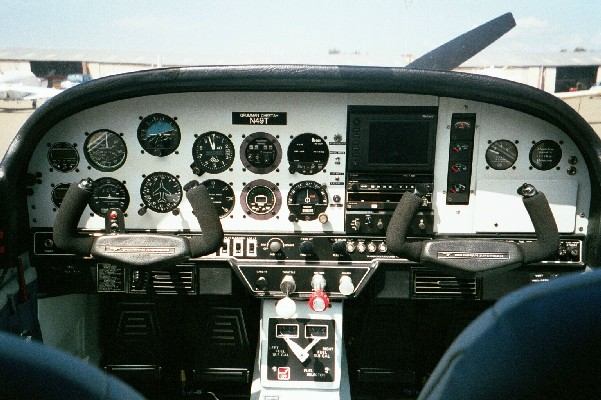 The cockpit of an American Aircraft plane is surprisingly professional and ergonomic for such a simple, low-priced aircraft. Controls are placed in logical locations, and the seating is comfortable, with plenty of elbow room, compared to others in their class. With such a low-cost aircraft, a little extra money is left over for outfitting the cockpit with expensive instrumentation. Most of them come with a well-equipped panel of instruments, adequate for basic instrument flight ("blind flying" in the clouds or total darkness), and many are outfitted with a "full IFR (instrument flight rules) panel," permitting safe, routine all-weather, day-and-night flight in the clouds -- for properly trained pilots.
The cockpit of an American Aircraft plane is surprisingly professional and ergonomic for such a simple, low-priced aircraft. Controls are placed in logical locations, and the seating is comfortable, with plenty of elbow room, compared to others in their class. With such a low-cost aircraft, a little extra money is left over for outfitting the cockpit with expensive instrumentation. Most of them come with a well-equipped panel of instruments, adequate for basic instrument flight ("blind flying" in the clouds or total darkness), and many are outfitted with a "full IFR (instrument flight rules) panel," permitting safe, routine all-weather, day-and-night flight in the clouds -- for properly trained pilots.
The single-engine planesí free-castering nosewheels -- requiring steering to be done with the brakes -- have given pilots and line crews fits, from time to time. But once learned well, they have their advantages -- particularly a very tight turning radius. Early models had a simple spring-steel nose gear, and fiberglass main gear legs, and no shock absorbers to dampen the bounce -- resulting in a plane with a lot of bounce, which could make for awkward landings and ground handling. Later models incorporated some shock absorbing in the nose gear, with good results.
 During the prosperous 1990s, American General Aircraft Corporation (AGAC) briefly revived the popular AA-5B Tiger line as the AG-5B Tiger.
During the prosperous 1990s, American General Aircraft Corporation (AGAC) briefly revived the popular AA-5B Tiger line as the AG-5B Tiger.
Today, Tiger Aircraft -- preparing to produce the Tiger -- holds up the torch for efficient excitement. The future looks promising for a plane that has always brought penny-pinching pizzaz to the general aviation market place.
RH
_____________________
 Return to
Return to